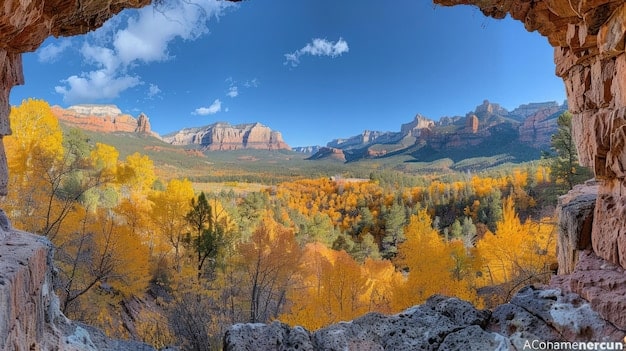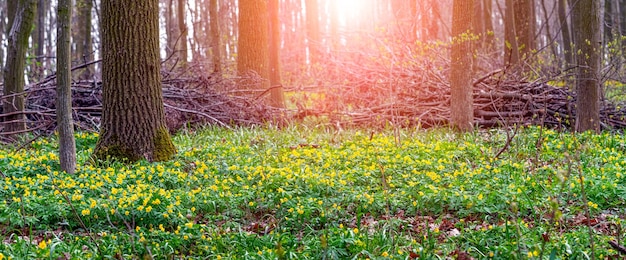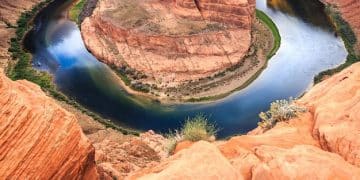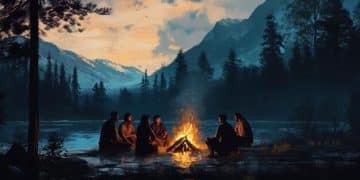Best Time to Visit US National Parks: Month-by-Month Guide

Discover the best time to visit US National Parks with our month-by-month guide, detailing weather conditions, crowd levels, and special events to help you plan the perfect outdoor adventure.
Planning a trip to one of the breathtaking US National Parks? The **best time to visit US National Parks: A month-by-month guide to weather, crowds, and events** is crucial for an unforgettable experience. This guide provides insights to help you make the most of your visit.
Choosing the Right Time for Your National Park Adventure
Each national park offers unique experiences depending on the time of year. Factors like weather, wildlife activity, and seasonal events significantly impact your visit.
Understanding Seasonal Variations
National parks experience distinct seasons, each bringing different benefits and drawbacks. Knowing what to expect can help you plan accordingly.
- Spring: Wildflowers bloom, and temperatures are mild in many parks.
- Summer: Peak season with warm weather, but also the most crowded.
- Autumn: Beautiful fall foliage and fewer crowds make it a great time to visit.
- Winter: Offers unique snow-covered landscapes and fewer visitors, but some areas may be inaccessible.
Consider what activities you want to pursue. Hiking is best in spring and fall, while winter is perfect for snowshoeing. Summer allows for water activities like rafting and swimming.

January: Crisp Air and Quiet Trails
January is the quietest month in many national parks, offering solitude and stunning winter landscapes. However, be prepared for cold weather and potential road closures.
Best Parks to Visit in January
Parks like Death Valley, Joshua Tree, and the Everglades offer milder temperatures, making them ideal destinations.
For winter sports enthusiasts, consider Rocky Mountain National Park or Yellowstone, where you can enjoy cross-country skiing and snowshoeing.
January can be unpredictable in terms of weather. Always check the park’s website for road closures and safety advisories before your visit.
February: Fewer Crowds and Winter Wonders
February continues the trend of fewer visitors, allowing for a more serene experience. It’s a great time for snow activities and wildlife viewing.
Exploring in February
Zion National Park’s lower elevations are accessible, providing stunning views of the red rock formations dusted with snow.
Acadia National Park in Maine offers a unique winter experience with carriage roads perfect for cross-country skiing.
- Check weather conditions frequently as snowstorms can impact travel.
- Dress in layers to stay warm in fluctuating temperatures.
- Bring binoculars for enhanced wildlife spotting opportunities.
February is perfect for those seeking quiet contemplation and dramatic winter scenery in the US National Parks.
March: Transitioning to Spring
March marks the transition from winter to spring, bringing variable weather and the beginning of wildflower season in some parks. It’s a time of renewal and change.
Parks in Bloom
Great Smoky Mountains National Park starts to show signs of spring, with wildflowers emerging in the lower elevations. This is a beautiful time for hiking and exploring the forest.
In Carlsbad Caverns National Park, the milder temperatures make it an excellent time to explore the underground caves.
- Be prepared for changing weather conditions, including rain and occasional snow.
- Check the park’s website for wildflower updates and guided tours.
- Bring rain gear and sturdy hiking boots.
March is ideal for nature lovers looking to witness the early signs of spring in the US National Parks.

April: Peak Bloom and Mild Temperatures
April is often considered one of the best months to visit many national parks, with mild temperatures and vibrant displays of wildflowers. It’s a fantastic time for outdoor activities.
Top Destinations in April
Shenandoah National Park’s Skyline Drive opens, offering stunning views of the blossoming landscape. Hiking trails become more accessible and enjoyable.
Arches National Park in Utah sees comfortable temperatures, perfect for exploring the unique rock formations.
Wildlife starts to become more active, providing opportunities for viewing animals in their natural habitats.
May: Ideal Weather and Outdoor Activities
May offers some of the most pleasant weather conditions across a wide range of national parks. It’s a sweet spot before the summer crowds arrive, making it perfect for hiking, camping, and wildlife watching.
Planning Your May Visit
Glacier National Park begins to open its Going-to-the-Sun Road, providing access to stunning mountain scenery.
Mount Rainier National park displays beautiful meadows of wildflowers, with opportunities for hiking trails.
Consider less-visited parks like Congaree National Park in South Carolina for a unique swamp hiking experience.
June: The Start of Summer Crowds
June marks the beginning of summer, bringing warmer weather and larger crowds to national parks. Despite the increased visitation, there are still plenty of opportunities to enjoy the outdoors.
Managing the Crowds
Yellowstone National Park is at its busiest, but the geysers and wildlife are well worth the visit. Plan your trip early and make reservations in advance.
Acadia National Park offers pleasant coastal weather and stunning ocean views. Take advantage of the park’s shuttle system to avoid parking issues.
Explore lesser-known trails and backcountry areas to escape the crowds and enjoy a more peaceful experience.
July: Peak Season and Warm Weather
July is the busiest month for many national parks, with families on vacation and warm weather drawing large crowds. Be prepared for higher prices, traffic congestion, and crowded trails.
Surviving Peak Season
Grand Canyon National Park is hot, but the views are spectacular. Hike early in the morning or late in the afternoon to avoid the heat.
Rocky Mountain National Park offers hiking trails, but parking can be challenging. Arrive early or use the park’s shuttle system.
- Make reservations well in advance for lodging, campsites, and tours.
- Bring plenty of water and sunscreen.
- Be patient and courteous to other visitors.
July can be challenging, but with proper planning, you can still have an amazing experience. Consider visiting during the weekdays to avoid weekend crowds.
August: Continued Warm Weather and Crowds
August is similar to July, with warm weather and continued crowds at most national parks. It’s a time for outdoor activities and enjoying the summer season.
National Park in August
Sequoia National Park offers a view of giant trees and hiking trails. Be sure to check for wildfire activity before your visit.
Olympic National Park in Washington State provides diverse landscapes, from mountains to rainforests. Explore the coast to see the rugged coastline.
Consider visiting less-visited areas of popular parks to escape the crowds. Backcountry camping requires permits, but it offers a more secluded experience.
September: Autumn Arrives and Crowds Diminish
September is a favorite for many park enthusiasts as the summer heat fades, the crowds thin out, and fall colors begin to emerge. It’s an excellent time for hiking and photography.
Enjoying the Autumn Season
Zion National Park offers comfortable temperatures and stunning fall foliage, making it a top destination. Hike the Narrows or Angels Landing for unique views.
Acadia National park displays vibrant trees. Drive the Park Loop Road for panoramic views.
Check the park’s website for updates on fall foliage conditions and ranger-led programs.
October: Fall Foliage and Crisp Air
October brings crisp air, beautiful fall foliage, and fewer crowds to many national parks. It’s a perfect time for scenic drives, hiking, and wildlife viewing.
Leaf Peeping Destinations
Shenandoah National Park’s Skyline Drive is at its peak, revealing colorful landscape vistas. Stop at overlooks to capture the best views.
Great Smoky Mountains National Park offers diverse autumn displays with sugar maples. Hike the trails to fully immerse yourself in the foliage.
Stay aware of weather forecasts, as temperatures can drop quickly in the evenings.
November: Transition to Winter
November marks the transition from fall to winter, bringing cooler temperatures and the possibility of snow to many national parks. It’s a quieter time for visiting, but some areas may be closed.
Preparing for Winter Conditions
Grand Canyon National Park’s North Rim closes for the season, but the South Rim remains open. Enjoy the views with fewer crowds.
Yosemite National Park offers stunning winter landscapes, but tire chains may be required. Check road conditions before your visit.
- Bring warm clothing and layers.
- Be prepared for snow and ice.
- Check the park’s website for closures and advisories.
November is for travelers who enjoy solitude and don’t mind colder conditions.
December: Winter Solitude and Holiday Festivities
December is one of the quietest months in national parks, offering a peaceful experience and unique winter scenery. Some parks host holiday events, making it a festive time to visit.
Winter Activities
Rocky Mountain National Park has snowshoeing and cross-country skiing, providing winter activities in a snowy environment.
Bryce Canyon National Park displays the hoodoos dusted with snow, creating magical scenery. Be prepared for cold temperatures and icy trails.
Bring winter gear, including hats, gloves, and waterproof boots. Check the park’s website for holiday event schedules.
| Key Point | Brief Description |
|---|---|
| ☀️ Summer Months | Warmest weather, but also the most crowded parks. |
| 🍁 Autumn Months | Fewer crowds and colorful foliage. |
| ❄️ Winter Months | Quiet trails and snowy landscapes, but check for closures. |
| 🌸 Spring Months | Wildflowers bloom and temperatures become more pleasant. |
Frequently Asked Questions
▼
January and February are generally the least crowded months due to colder temperatures and potential road closures. This time allows for a more peaceful and solitary experience in the parks.
▼
Glacier National Park is great in the summer with its open Going-to-the-Sun Road and pleasant weather. Always make reservations and plan activities to mitigate potential challenges in the busiest time of the year.
▼
Pack essentials like sturdy hiking boots, layers of clothing, sunscreen, a hat, sunglasses, plenty of water, and a first-aid kit. Also, bring a map, compass, or GPS device for navigation.
▼
Spring and fall usually offer the best opportunities to see wildlife as animals are more active during these seasons, either emerging from hibernation or preparing for winter. Dawn and dusk are optimal viewing times.
▼
It’s recommended to book lodging or campsites several months in advance, particularly if you’re visiting during the peak season. Some popular parks require reservations up to a year in advance.
Conclusion
Choosing the **best time to visit US National Parks: A month-by-month guide to weather, crowds, and events** depends on your preferences and priorities. Whether you seek solitude in winter, vibrant wildflowers in spring, or autumnal landscapes, each season offers its unique charm. Planning ahead will help ensure a memorable and enjoyable experience in these treasured natural landscapes.





